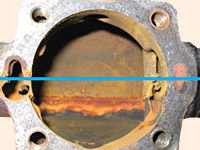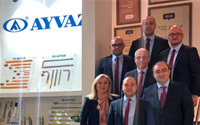- Corporate
- Products
- Expansion Joints
- Flexible Metal Hoses
- Level Controllers
- Steam Equipment
- Valves
- Globe Valves
- Bellow Sealed Stop Valves
- Gate Valves
- Dismantling Joint
- Check Valves
- Ball Valves
- Butterfly Valves
- Actuators and Worm Gears
- Strainers
- Balancing Valves
- Pressure Reducing Valve
- SCHNEIDER Manometer Valves
- FCU On-Off Valves
- Solenoid Valves
- Earthquake Valves
- Hydraulic Control Valves
- Safety Valves
- Water Hammer Absorber
- Vacuum Lifters
- Insulation Products
- Fire Fighting Equipment
- Separators
- Certificates
- Publications
- Gallery
- Contact
- + Language
News
Follow the news about Ayvaz

The Corrosion Problems in The Condensate Lines
Power stations and the big industrial energy stations have the most scientific water treatment systems, chemicals and equipment known but especially, smaller sized stations, hotels, launderettes, glasshouses, dyeing plants and other steam using facilities may not have the required conditions.
- What is the general reason of corrosion?
- Is oxygen a corrosive fluid?
- How do the oxygen and carbon-dioxide get in the systems?
- Which corrosive materials cause pitting?
- What is the reason of boiler incrustation?
- How does boiler incrustation affect the boiler’s performance?
- How do the materials that cause the boiler incrustation get in the outflow system?
- What is the carryover and how does it happen?
- What are the main ways to prevent the boiler incrustation?
Power stations and the big industrial energy stations have the most scientific water treatment systems, chemicals and equipment known but especially, smaller sized stations, hotels, launderettes, glasshouses, dyeing plants and other steam using facilities may not have the required conditions. This article is on to explain the problems caused by corrosion and how to solve them.
CORROSITION
The corrosion in the outflow condensate lines usually develops slowly in time and does not cause anxiety first. But the corrosion growing up rapidly is actually serious enough to cause a great anxiety and cost. Normally corrosion happens with oxygen or carbon-dioxide to dissolve in the system. The mixture of these two gases has more corrosive affects than each one of them individually.
The photographs given with this article show the general and serious effects of the corrosion.
The solution in the condensate contains carbon-dioxide and carbon dioxide cause carbonic acid. The corrosion which is generated by carbonic acid has a melting effect on the metals.
Oxygen cause serious local corrosion where the tension and other corrosive reasons are present, generally in the pipelines that two different metal cause a repulsion.
The corrosion prepared by the oxygen usually appears in a way of carving, getting rid of the oxygen reduces the level of the corrosion.
That is because, dissolved carbon-dioxide and oxygen exist in the feed water of boilers, these gases typically enter the steam systems. Even it is thought to be pure, rainwater tends to transport dissolved carbon-dioxide and oxygen collected from the atmosphere. Crude carbonates dissolved in groundwater will carry carbon dioxide to a system. Even there are water treatment techniques that release carbon dioxide.
It is not the only way that the dissolved oxygen carried in water supply, but it also enters the system by the leaks in the vacuumed return lines and the drop-down places open to the atmosphere. There are many various ways to prevent corrosion caused by oxygen and carbon dioxide. These include feed water heaters, deaeration feed water heaters, vents, and chemical treatment.
The boiler incrustation on the parts of steam traps is seen in the photographs given with this paper. It can practically be thought that the condition of the valves, pumps and other equipment are the same at the return lines where these steam traps belong.
The reason of the boiler incrustation is the tough water in broad words the water contents dissolved minerals such as calcium carbonate and magnesium sulphate. Groundwater contents a large amount of these minerals taken from the soil also the water taken from lakes can be counted as too tough for the steam systems, even the treated and city water is considerably though. Technically the water does not content an amount of those minerals that may cause serious damage in the boilers and pipelines are classed as “soft of not too tough”. The degree of toughness which is measured as the one in a million ppm or lbs. of dissolved minerals set the rate of the boiler incrustation. If any level of toughness exists, sooner or later boiler and the return pipeline will face incrustation problems.
Boiler Incrustation causes two kinds of problems in the Boilers;
- REDUCE OF THE HEAT TRANSFER RATE- The incrustation in the boiler pipes can reduce the heat transfer rate by a quite high amount and that decreases the working performance and increases the costs as a result of the high fuel consumption.
- DAMAGE OF BOILER PIPES- In time, the decrease of heat transfer reaches great amounts and the temperature of metal pipes goes up to dangerous levels. High temperatures damage the boiler pipes and cause a great danger for the system.
Although the solution against the incrustation effect of the tough water is easy, it may take a quite complex shape. Most of the users know about the standard boiler chemicals and use them to solve the problem.
It is suggested to work with water treatment firms in order to share their experience against the incrustation effect of the tough water. Many examples proofs that the water treatment is the main solution to get rid of the incrustation from the boiler and prevent it to happen in the steam system. The investment on water treatment will pay itself shortly by increasing the efficiency of the system.
CARRYOVER: If only the pure water is carried in the steam lines, how could it be possible to see the boiler incrustation in the return lines? The answer has various names such as carryover, foaming, boiler boiling, water elevation and caused by a different issue.
Some of those issues and their reasons might be a little different but, the results are always the same. The condensate that occurs with the entry of the pure steam to the system is also pure and harmless, but if oxygen and carbon dioxide enters the system with this pure steam that causes corrosion. In such cases, the water in the boiler goes up and enters to the steam line and carries the harmful materials to the system. This is the main reason of the incrustation in the return lines and steam traps.
The reason of boiler foaming is usually, high alkalinity, dissolved solid materials in the water and oil. Appropriate blow-off applications can solve the issues caused by high dissolved solid material rate of the water. Proper water treatment and providing the right working conditions suggested by the experts could be the solution.
Elevation of the Boiler water is caused by the high loading and rapid pressure drop. Sometimes it may be the result of the boiler capacity not the meet the daily loading. In many cases the problem can be solved by applying separators and purifiers that control the water and purify from those dissolved materials.
CONCLUSIONS
- Water is not naturally pure
- The water which is not pure causes boiler incrustation, corrosion and carryover.
- Proper water treatment, blow-off applications and working condition will solve the problem.
- The investment on proper water treatment will pay itself shortly by increasing the efficiency of the system.
CORROSION IN THE STEAM HEATING SYSTEMS
The corrosion in the condensate carrying part of the steam heating systems is a quite complex issue. Pure water definitely does not cause any corrosion itself, which means if we come across with incrustation in a steam heating system; the reason is the dissolved materials in the condensate that reacted with the metal surfaces. Oxygen and carbon-dioxide are the main components of the condensate and have a big dissolving intensity in the water also these gases are responsible of the corrosive action. If they exist in the feed-water of the boiler, they may enter the steam heating systems. The atmospheric oxygen may enter steam and return systems where rapid pressure drops are happen. Even it is a very easy process to prevent the oxygen in the boiler water, because of occurred carbonates and dissolution of them under the boiler water’s temperature; it is quite difficult to come over carbon-dioxide.
OXYGEN CAUSE CORROSION
When there is no carbon-dioxide but dissolved oxygen exists in the system. Because of the corrosive accelerating effect of oxygen, corrosion will become inevitable and appear in a carved local corrosion form. Local corrosion appears as anodic little areas where the metal gets in the condensate and as cathodic large areas where the metal surface is protected. In anodic areas may be caused by the contact of different kind of metals, slag to join the system or the tension risen up on the metal surfaces like threaded connections. Oxygen’s accelerating effect on this kind of collision is the result of the hydrogen which is collected in cathodic areas and its negative affect on polarization.
RESULTS OF THE PITTING
In such cases that corrosion is caused by the existence of dissolved oxygen in return lines, pitting occurs and insoluble materials like ferric oxides are collected in narrow spaces. Basically the corrosion which is caused by carbon di-oxide appears in a carved shape. In these areas, metal surfaces dissolve like to be dissolved by a low acidic solution. When carbon di-oxide is the, corrosive action is the function of both concentration of carbonic acid and the amount of the condensate that exceeds the limitation.
The amount of dissolved carbon di-oxide in condensate is the degree of acidity. As the amount of carbon di-oxide rises, power of the acidic reaction and the corrosion speed rise up as well. When the acidic condensate dissolve the iron, the pH degree of the solution increase up to a level that the acidic attack is not possible anymore. Beyond that point, oxygen becomes the controlling factor and carved areas occur. The most efficient corrosion which is caused by the existence of carbon di-oxide occurs where the biggest part of the system condensation is.
As the sum of all the information given above, we can say if there is an air entry to a steam system, oxygen would increase the corrosive effect, but it would not have any effect on the corrosion that is caused by the carbon di-oxide existence.There are several methods to control the corrosion which is the result of the existence of carbon di-oxide in the return lines. The fouling of the steam by oxygen can be prevented by deaerating the feed-water and chemical cooling the oxygen in the boiler water. It is a hard process to get rid of the carbon di-oxide. In cases that carbon di-oxide exists on its own in condensate lines, if a proper water treatment and the controlling actions are not taken, active corrosion becomes regular.
Erhan LAK
Level & Steam Traps Production Manager
Ayvaz A.Ş.
elak@ayvaz.com
CHECK OUT THE OTHER NEWS
Ayvaz is certified by ASME for its capability to produce in American Standards
ASME (The American Society of Mechanical Engineers) is a very well established organization which was founded in 1880. ASME specifies the production procedures of press... Read the article
World’s one of the leading HVAC exhibition ISH has just finished
The ISH kept its door open for 5 days with its new concept. 190 000 visitors from 161 countries made their way to ISH and 2 532 exhibitors from 57 countries presented t... Read the article
Ayvaz will participate in the world’s leading trade fair ISH
ISH is one of the world's leading trade fairs for building, energy, air-conditioning technology and renewable energies. With around 200.000 visitors and over 2 500... Read the article
PRODUCT SEARCH
NEW PRODUCTS
CUSTOMER SATISFACTION SURVEY
- Click HERE to join our customer satisfaction survey!



